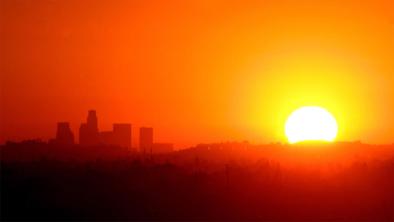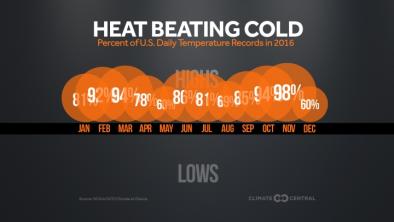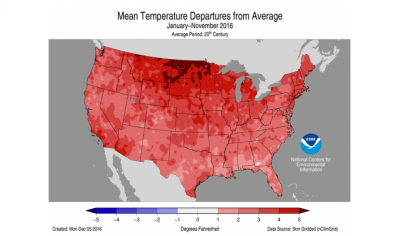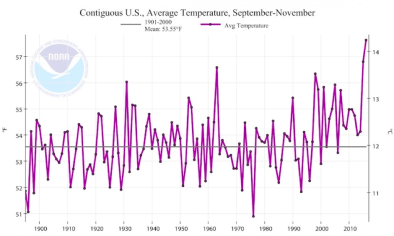Earth's warm October not record; 2016 likely record hot

While last month merely tied for the world's third warmest October in history, 2016 is still on track to be the hottest year on record, federal meteorologists said Thursday.
The National Oceanic and Atmospheric Administration announced that the globe averaged 58.4 degrees (14.7 Celsius), which is 1.3 degrees (0.7 Celsius) warmer than the 20th-century average but not as warm as Octobers in 2015 and 2014.
From May 2015 to August 2016, Earth set monthly heat records for 16 straight months.
Scientists blame continued man-made climate change from the burning of fossil fuels, goosed by a now-gone El Nino. El Nino is the occasional natural warming of parts of the Pacific that changes weather worldwide.
The first 10 months of 2016 have been the hottest year to date, averaging 59.15 degrees (15.07 Celsius). That beats 2015 by .18 degrees (.1 Celsius).
NOAA climate scientist Jessica Blunden said it is likely that this year will eclipse 2015 as the hottest year on record . If November and October are just average for the 21st century, it will set a new record. But Blunden said a weak La Nina, the cooling flip side of El Nino, provides a small possibility that 2016 will slip slightly behind 2015.
Still, 2016, 2015 and 2014 will go down as the three hottest years on record "however they stack up," Blunden said. Records go back to 1880.
Since 2000, the globe has set 42 monthly heat records and four annual heat records. No global monthly records for cold have been set since December 1916. New Mexico had its hottest October on record, while neighboring Arizona, Texas, Oklahoma and Colorado had near record heat for the month.
NOAA meteorologists said the Arctic was unusually warm for a long period of time, both before and after the strong El Nino. Parts of Greenland, including the top of Greenland's ice sheet, were more than 13 degrees (more than 7 Celsius) warmer than average last month.
There has been "a meteoric rise in October temperatures on Alaska's north slope," said Rick Thoman, NOAA's climate science and services manager in Alaska.
The average October temperature in 2016 in Barrow, Alaska, was 30.2 degrees, nearly double the 20th century normal of 15.6 degrees. And the last 15 years have all averaged more than 20 degrees in October in Barrow.
"Since October 2001, there have been no cold Octobers (in Barrow), not one," Thoman said. "This change is the direct result of the really catastrophic loss of autumn sea ice on Alaska's north coast."
Arctic sea ice in October — the first full month when sea ice is supposed to grow in the region — set a record low for the month, Blunden said. She called the Arctic the "canary in the coal mine" for global warming.
Related Content






